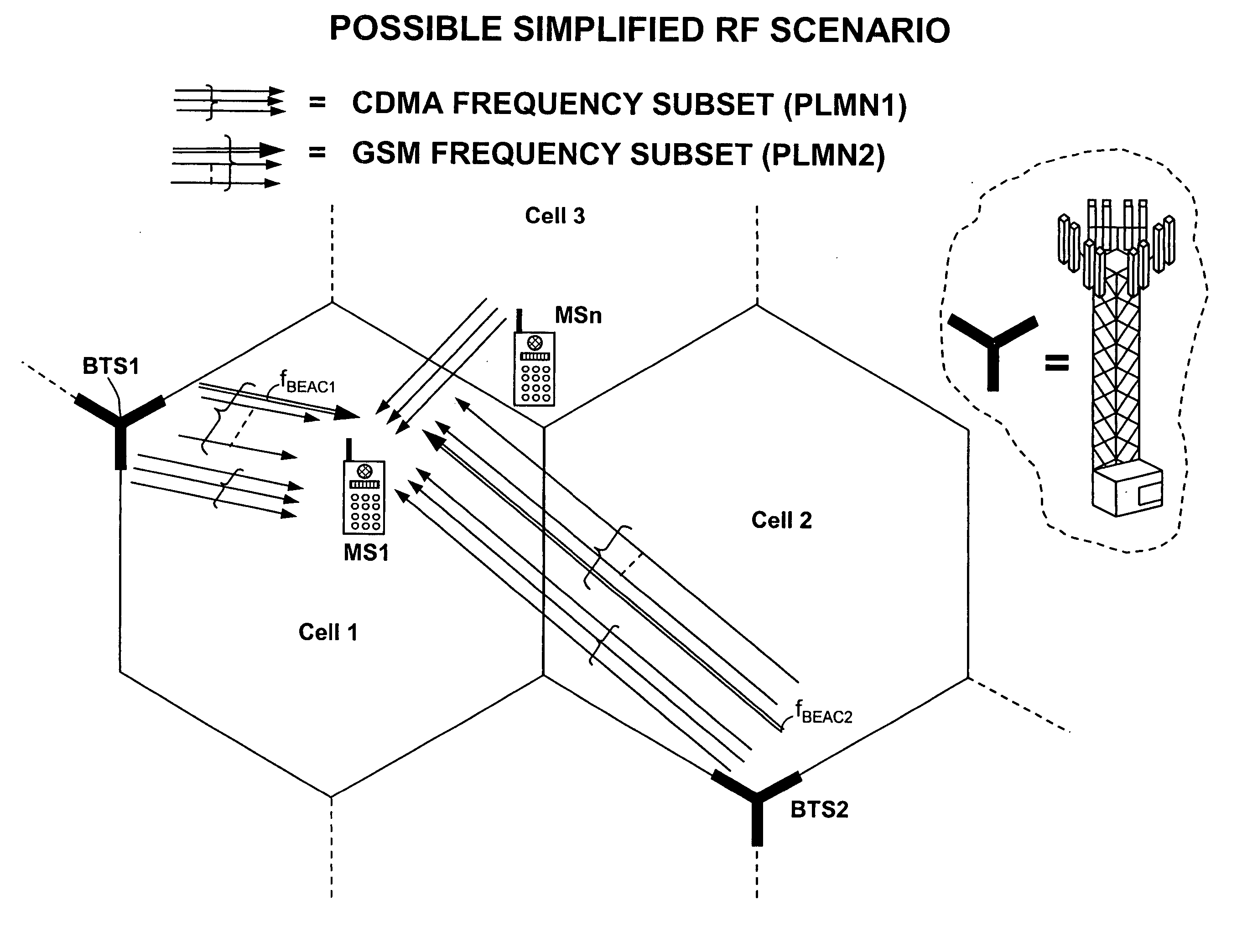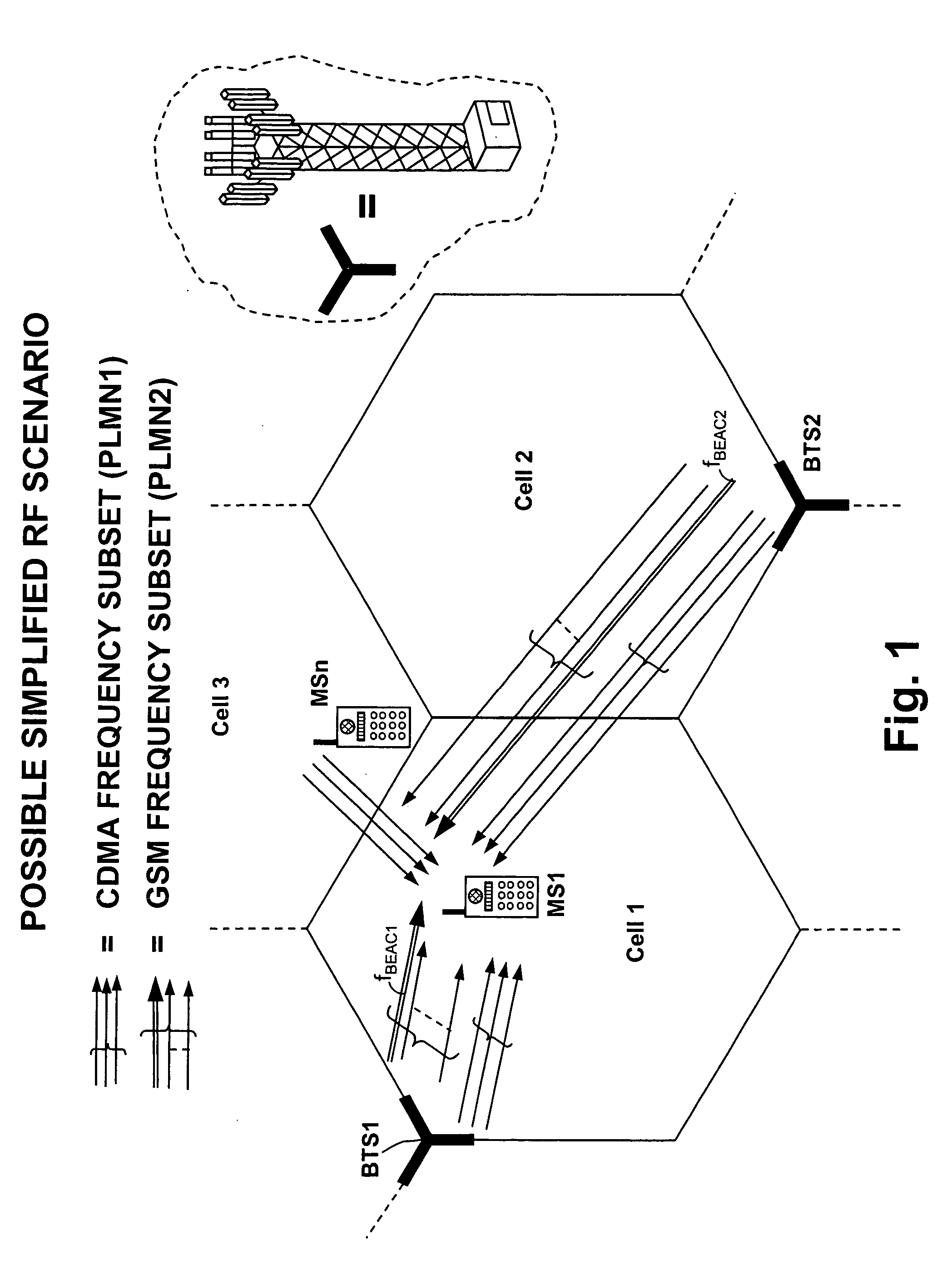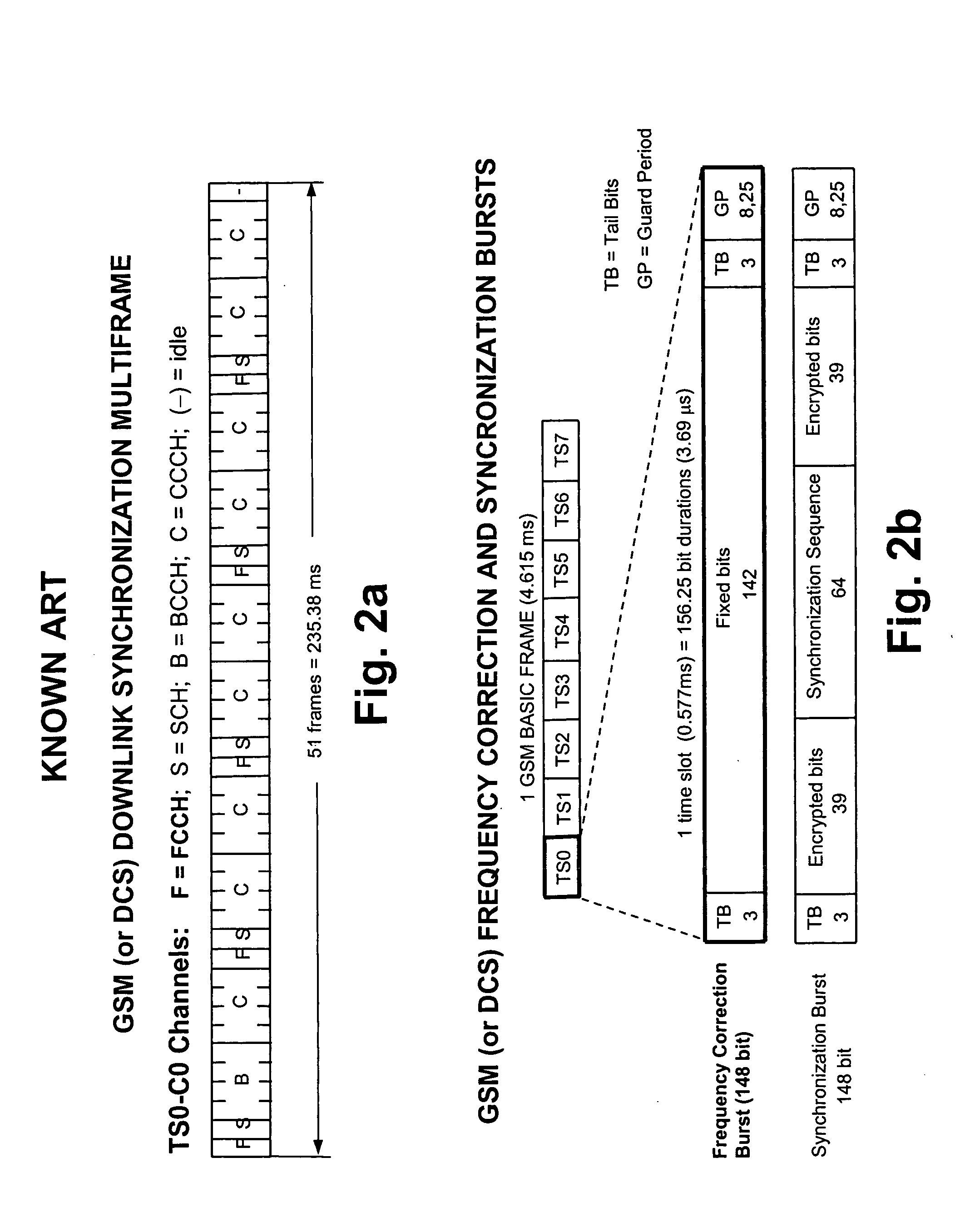To achieve said objects the present invention suggests a method for initial cell searching, as disclosed in the method claims. Further subject of the invention is a
Mobile station which performs the claimed method, as disclosed in the device claims.
As disclosed in the claims, the method of the invention completes the frequency scan in the band of interest before passing to the correlation step for the detection of a cell. In that the frequency scan is performed continuously without introducing correlation steps, but exploiting the only spectral information originated from the
transmitted power. This seems novel in respect of the cellular systems of the prior art where the steps of the frequency scan are interleaved with step of correlation with a
pilot channel common in the whole
system (like the
FCCH and SCH bursts of the
GSM, or the P-SCH burst used in both W-CDMA and UTRA-TDD-HCR). No mention of an initial frequency scan procedure like the one of the invention is treated in the specifications. The disclosed technical feature is useful in those systems in which a common
Pilot is not foresee to synchronize the
mobile station downlink, but the only synchronization tool is a set of synchronization sequences associated with the cells one-to-one. The
advantage of the proposed method is that do not interleave a cumbersome correlation at each frequency step. Besides, the two-
step frequency scan, firstly rough and then fine, considerably speed up the scan operation because an only subset of all the permissible frequencies is examined. The generality of the method covers systems other than TDD and it can be easily arranged even for those systems in which a common
pilot exists, in this eventuality the initial
cell search could be sped up by completing the two-
step frequency scan, firstly, and then perform correlation between the only digital set of the final selected frequency and the synchronization burst SCH common to the whole
system. In the
GSM case this way of operations leads to the BSIC and the BCCH channel with a single correlation step, while in case of W-CDMA and UTRA-TDD-HCR successive correlation steps with all the possible Secondary SCH (16) are needed. In both the case the overall number of correlations is much lower than the conventional approach. A big deal of innovation of the present invention is the analysis of the shape of the power evaluated over a certain
time duration of the
signal (typically a frame), necessary because of the absence of a continuously
pilot channel in the
system.
As far as the power measurement concerns, a
baseband frame (5 ms) is stored at each frequency step. The stored signal is subdivided in blocks spanning half timeslot duration and the power of each block is calculated. Blocks as wide as half timeslot constitute an optimal choice for TD-SCDMA systems in which P-CCPCH and Dw-PTS occupy two adjacent timeslots, the length could be reasonably varied to meet other PLMNs. The resulting shape of the
power envelope reflects a trade-off between the need to give a realistic representation of the
fading and that to save the unitary concept of timeslot, so the envelope along a timeslot shouldn't vary too much. A final criterion valid for PLMNs other than TD-SCDMA should be that to have blocks long at least half the duration of a synchronization sequence, because the last is usually shorter than a service burst. This criterion maximizes the peak of the calculated
power envelope.
According to the invention, for each scanned carrier the power of the strongest block in the frame is stored in a spectral table of the MS and those carriers associated to the strongest blocks are selected at the rough scan. The same criterion is used for the selection of the final carrier with fine scan. This criterion is simple and reliable in almost all the real conditions. Suppose an MS located in a first cell and an adjacent cell is transmitting on the same frequency (the considered system is CDMA-TDD), the MS always measures in correspondence of the common frequency a power which is the summation of the signals received from both the cells, this is true for all the timeslots. The
common carrier enters the spectral table of the MS with the power of the strongest block as it results from the contributions of the two cells. The summation of the powers received from the two cells increases the probability that the common frequency be selected. Even in this circumstance the successive correlation step discriminates between the
SYNC code of the two cells thanks to the good autocorrelation property of said codes and their poor cross-correlations. Downlink synchronization of adjacent cells is not a strictly mandatory requirement for the method of the invention, nonetheless it is a feature particularly useful in TDD systems, especially for those Mobile Stations located midway two cells. In this context the
frame synchronization allows to perform more realistic selection, as will be cleared up later on.
The method of the invention additionally introduces the “load” of a frame as a new indicator suitable for the initial
cell search. The frame load indicator is calculated from the shape of the
power envelope along the considered frame, it corresponds to the percentage of timeslots over a calculated power threshold. Frame load indicators have been advantageously included in the spectral table near the respective strongest blocks (see % Busy of FIG. 12). Under certain hypotheses this indicator gives an idea of how many timeslots in a frame are busy, for example because engaged in traffic operations. “Unloaded” frames have higher probability to include free timeslots than “loaded” frames. In case two carriers have almost the same power of the respective strongest blocks, the selection of the carrier with lower load indicator will increase, on average, the successfully attempts in call set up. It's useful point out that the aforementioned
selection criterion based on the strongest block allows a frame with
low load to be chosen, because at least one timeslot (DwPTS, TS0) is always transmitted with maximum or nearly maximum power. A condition for a reliable frame load indicator is the poor influences of the neighbor cells, as it certainly happens indoor or when the MS is far from the cell boundary. Inside isolated or nearly isolated cells the frames with equal load indicators also include the same number of busy blocks, otherwise the busy indication is misleading because a block can surpass the power threshold to be considered busy thanks to the significant contributes of the neighbour cells.
For
radio access systems based on Time Division Duplex (TDD) mode, like the TD-SCDMA, the frame timing synchronization is an important feature to minimize interferences and optimize the offered
traffic capacity. Frame timing synchronization may imply: slot, frame, multi-frame or hyper-
frame synchronization within BTSs of the network. Time
slot synchronization avoids a disturbing radio link on a time slot to affect radio links on two time slots in a neighbouring cell.
Frame synchronization ensures that uplink and
downlink transmission directions are positioned, at least for adjacent cells, at the same instant; this prevents a receiving mobile (MS1 of FIG. 1) to be saturated by near transmitting mobiles (MS2 of FIG. 1) camping in a neighbouring cell (cell 3). Control multi-
frame synchronization ensures that the same type of logical channel (e.g. PCH, BCCH, . . . ) is broadcast by adjacent cells at the same time-frame; this allows to speed up the cell re-selection process in the MSs, without discontinuity in detecting the relevant
system information. Frame timing synchronization can be achieved in different ways or combinations, i.e.: sending the synchronization pulses via cable; equipping the BTSs with a GPS (
Global Positioning System)
receiver for detecting the time reference signal; and finally using a
radio channel to synchronize
over the air the base stations to each other, as disclosed in the international
patent application WO 01 / 17137 filed on 24-07-2000 in the name of the same Applicant.
 Login to View More
Login to View More  Login to View More
Login to View More 


